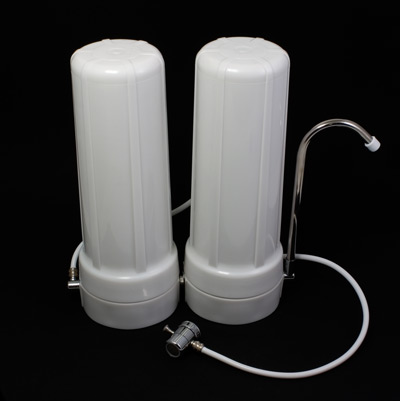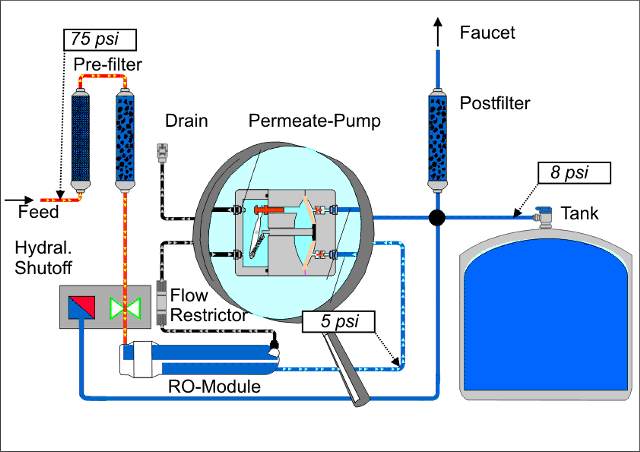Fifty years after it was introduced to prevent tooth decay
Is Fluoride in our Water a Mistake?
by Philip Frazer
White splotches, most noticeable on the front teeth, the enamel sometimes pitted or striped as if with flat white paint. Sometimes the discoloration is brown. If you haven’t seen this on people’s teeth in your neighborhood, your water is probably not fluoridated.
It’s called dental fluorosis and it’s caused by ingesting too many fluoride compounds (usually called simply “fluoride”) while the teeth develop. Someone with this mottling of the enamel could also have suffered bone damage or skeletal fluorosis And a child with these problems will have them forever because fluorosis is irreversible.
How could it be that after fluoride has been promoted for 50 years as a benefit to every one of us, it turns out to be a bad idea? Haven’t the people who question fluoridation been cranks and paranoids?
Today, those lining up against fluoride in tap water and toothpaste include reputable medical and dental researchers and doctors, dentists, public health officials and the governments of most European countries including Sweden, the Netherlands, France and Germany.
Of the nearly 250 million people worldwide who drink fluoridated water, about 130 million are Americans. Out of our 50 largest cities, 41 have fluoridated water.
Does It Work?
Having kids drink fluoridated water was supposed to cut the incidence of dental cavities.Most researchers, politicians and dental professionals say it does just that, but equally qualified people are questioning that conclusion as well as the data gathered over the past 50 years (see, for example, the Health Canada Protective Branch Report, July 2, 1994). While conspiracy theories persist, most critics are raising serious questions such as, whether reduced cavities are due to fluoride or other things, like better education about tooth care.
The establishment and the critics throw epidemiological studies at each other. Fluoride proponents have many more studies, going back to the 1940s, but many reputable scientists have revisited the classic fluoride studies and concluded that they were fatally flawed.
News on Earth does not pretend to have reviewed all the studies, but we believe the fast-rising epidemic of dental fluorosis, coupled with the fact that most countries on Earth have decided against fluoridation, means it’s high time to reconsider fluoridation. Certainly we shouldn’t increase the percentage of Americans getting compulsory fluoridation via tap water from 62% now to 75% by 2000, a stated goal of the Clinton administration.
Though the administration parrots the reassurances of the dental establishment, we found more critical and independent thought coming from the government of a town just outside of Boston.
Last year the town of Natick, Mass. put together a panel of experts with no axes to grind to decide whether the community should add fluoride to its water. Chairman Norman Mancuso, Ph.D., has been a chemical engineer, a postdoctoral fellow at Massachusetts Institute of Technology and a project scientist at NASA on the Apollo Program. The other four panelists all had advanced degrees and extensive experience in chemical risk assessment, in three cases, with the US Army.
Their report concluded “unanimously and emphatically” that fluoridation was a bad idea, in part because “there is little or no difference between . . . the incidence of cavities in children [in] fluoridated and non-fluoridated communities.”
Worldwide research suggests that tooth decay rates have gone down just as much where there is no fluoridation. Some examples:
British Columbia, with 11% of its population drinking fluoridated water, compared with 40-70% in other Canadian regions, has the lowest rate of tooth decay in Canada.
Many recent studies published in Caries Research and the Journal of Dental Research conclude that dental decay rates in Western Europe, which is 98% unfluoridated, have declined as much as or more than they have in the US. In 1986-87, the National Institute of Dental Research conducted the largest study on fluoridation and tooth decay ever, tracking 39,000 US schoolchildren between the ages of 5 and 17. A third lived in fluoridated areas, a third were partially fluoridated, and a third were unfluoridated. The study, concludes the Natick report, showed no statistically significant differences in dental decay between fluoridated and unfluorfidated areas.
Recently, fluoride proponents have revised their claims: Since 1988, the American Dental Association (ADA) has asserted that fluoridation can only reduce cavities by 18-25%, which is down from its previous claim of 40-60%.
The Natick report cites new research suggesting that any cavity-preventive action of fluoride comes from it being in saliva and not by hardening enamel as was long theorized. That would mean that it should be applied directly to the mouth, not pumped into the body via tap water.
Fluorides Are a Major Industrial Waste Product
Fluoride is a toxic pollutant. It’s part of the smokestack emissions from the manufacture of iron, steel, aluminum, copper, lead, and zinc. It’s released in the production of phosphates (used in all agricultural fertilizers); plastics; gasoline; brick, cement, glass, ceramics and the many other products made from clay. It’s emitted by coal-burning electrical power plants and uranium processing facilities. And fluoride is dumped into waterways by factories producing and processing glass, pesticides, fertilizers, chemicals and metals.
All these industries would have trouble disposing of their waste fluoride if they were not able to dump it or sell it to municipalities for adding to tap water.
The EPA’s 1989 estimate was that at least 155,000 tons a year are released into the air by US industrial plants, and as much as 500,000 tons a year are released into lakes, rivers and oceans. And because fluoride compounds are not biodegradable, they gradually accumulate in the environment, in the food chain and in people’s bones and teeth.
Even so, the EPA still says fluoridation is “an ideal environmental solution to a longstanding problem.” The “problem” is not so much tooth decay, but the huge amount of fluoride compounds produced as waste in industry. “By recovering by-product fluosilicic acid from fertilizer manufacturing, water and air pollution are minimized and water utilities have a low-cost source of fluoride available to them,” enthuses the EPA.
Fluoride Poisoning
What damage can fluoride do? In the worst case, fluoride poisoning can be fatal:
- In May 1992, 260 people were poisoned, and one man died, in Hooper Bay, Alaska, after drinking water contaminated with 150 ppm [parts per million] of fluoride. The accident was attributed to poor equipment and an unqualified operator at the fluoridation plant.
- In July 1993, three dialysis patients in Chicago died and five experienced toxic reactions to the fluoridated water used in the treatment process.
But these accidents are extreme cases. People at high risk from lower levels of fluoride poisoning include children, the elderly, people with impaired kidney function (including many people with AIDS), people with immunodeficiencies, diabetes and heart ailments, as well as anyone with calcium, magnesium and vitamin C deficiencies.
In nature, fluoride mostly occurs as calcium fluoride while what’s added to water supplies is mostly sodium fluoride or sodium silicofluoride (hydrofluorisic acid). Sodium fluoride is lethal in doses 50 times smaller than naturally-occurring fluoride.
Fluorosis
The ADA and the government consider dental fluorosis only a cosmetic problem. That’s no consolation to people whose teeth are blemished forever. But by designating it merely “cosmetic,” the feds are propping up the fluoridation enterprise. If fluorosis were redefined as an “adverse effect,” as many dental and medical professionals urge, the EPA would have to cut in half the admissible levels and that would radically reduce tap water fluoridation.
Furthermore, the American Journal of Public Health says that “brittleness of moderately and severely mottled teeth may be associated with elevated caries [cavities] levels.” in other words, fluoride can cause the exact problem it’s supposed to prevent.
What it does to bones
About half of the fluoride you drink or eat is absorbed in calcified tissues, like bones and teeth. The National Academy of Sciences and other authorities agree that a lifetime’s accumulation from large daily doses of fluoride can produce crippling skeletal fluorosis. This bone damage is widespread among older people in parts of the world where there are high concentrations of naturally occurring fluorides in the water, but few cases of skeletal fluorosis have been reported in the US. Critics claim we are missing diagnoses of skeletal fluorosis because most doctors in the US have not studied the disease.
The Natick report, several articles in the Journal of the American Medical Association, and EPA scientists all agree that fluoride increases the rate of hip fracture in people aged 65 or older.
Fluoride makes bones denser, which is why it is used in the treatment of osteoporosis, but it also makes bones more brittle (osteosclerosis).
Cancer
Recent research links fluoridation to a variety of cancers.
In 1977 Congress instructed the National Toxicology Program to investigate fluoride’s effects on lab animals.
But when its report was released in 1990, Dr. Robert Carton of the EPA’s Toxic Substances Division cried foul: “Four years ago, NFFE Local 2050, which represents all 1,100 professionals at EPA headquarters [said] that the scientific support documents for the fluoride in drinking water standard were fatally flawed…. The fluoride juggernaut proceeded as it apparently had for the last 40 years—without any regard for the facts or concern for public health.
“[The] EPA raised the allowed level of fluoride before the results of the rat/mouse study ordered by Congress in 1977 [were] complete….
“[The] currently existing data . . . show fluoride causes genetic effects, promotes the growth of cancerous tissue, and is likely to cause cancer in humans.”
The Natick report concluded that most studies of fluoride and cancer are flawed. . “Given the widespread deliberate exposure of. humans to water fluoridation and the suggestive animal data regarding cancer, especially osteosarcoma, it is incomprehensible why a large case-control epidemiological study. . . has not been initiated.”
Lead and arsenic
Meanwhile, other research has examined fluoride by-products from aluminum and phosphate (fertilizer) production, since the fluoride gets contaminated by lead and arsenic.
On top of that, fluorides in the water supply eat away the protective hydroxide coating in lead pipes in older homes, and then the pipes can and do leach lead.
Today one in nine children in the US under the age of 6 has unacceptably high blood lead levels, which some researchers believe may come from lead contamination in fluoride added to tap water consumed by pregnant women and passed on to their developing fetuses.
The EPA concedes that 10-20% of the lead in children comes from tap water, but that, they say, is too small to be of regulatory concern. Critics again point to its concentration over time in body tissue and the fact that we consume additional fluoride from products processed with fluoridated water.
Enzymes, brains and Alzheimer’s
The Natick report found that fluoride can “seriously disturb the balance of enzymatically activated biochemical reactions,” for example, “the metabolism of a number of common oral bacteria (e.g., Streptococcus mutans)….” The Natick panelists saw this as an area needing new study.
Another such area is damage to the brain or the central nervous system. In a recent article in the peer-reviewed journal Brain Research on the effects of aluminum on brain tissue, researchers reported that it was not aluminum but low levels of fluoride that caused damage to the tissue of the brain similar to the damage found in humans with Alzheimer’s and other forms of dementia.
An earlier study by Mullenix et al., reported in Nevrotoxicology and Teratology, in 1995, found that animals exposed to fluoride at various stages of gestation suffered either permanent hyperactivity if exposed prenatally, or became “the rat version of couch potato” if exposed after birth, though there was no elaboration of exactly what that is.
The Natick folks say “there is good evidence that fluoride . . . affects the IQ and behavioral patterns of the developing fetus at doses that are not toxic to the mother.”
The International Society for Fluoride Research has also reported studies implicating fluoride in the rising rates of Down’s syndrome, chronic fatigue syndrome and sleep disorders.
How much are YOU Consuming
Even though no “optimal” fluoride intake has ever been established, the EPA set a maximum contaminant level (MCL) for fluoride in 1986, at 4 mg per liter of tap water. The recommended doses for kids were revised in 1995, downward to 2 mg., and less for infants, to prevent fluorosis. It’s estimated that the average person consumes between 5 and 7 mg. per day in “optimally fluoridated” areas, from drinking water, dental products, and food and beverages made with fluoridated water. But a heavy coffee and tap water drinker, drinking 4 liters a day, is at risk for crippling bone fluorosis after 10 years, according to National Academy of Science figures, or 20 years, says the US Public Health Service.
Children can consume enough to develop fluorosis if their tap water is fluoridated and they drink reconstituted juices. Grape juice, for example, has been tested at almost 6.8 mg. of fluoride per liter..
The Natick report concluded that, if their town water was fluoridated, children under 3 would be likely to ingest “between 2 and 3.5 times as much fluoride as recommended by the American Academy of Pediatrics, American Dental Association and the American Academy of Family Physicians.”
Cooking with tap water can greatly increase a food’s fluoride content, and Teflon- and Tefal- coated items (such as frying pans) transmit very small amounts of fluoride into food.
Today, fluoride levels in toothpaste have risen to 4,000 ppm, and the warnings on the tubes are back, much to the annoyance of the ADA.
Children and adults commonly ingest up to 0.5 mg. of fluoride a day from toothpaste. Small children are now told to use no more than a pea-size amount, but young kids have less control over swallowing, and how many are sticking to the pea rule is impossible to say, especially when they’re enticed by bubble-gum-flavored brands.
Fluoride treatments commonly administered in the dentist’s chair contain between 10,000 to 20,000 ppm and there is no regulated dose requirement. In recent years, several deaths have been attributed to dental office treatments.
Why the juggernaut?
The scientific establishment in the US is largely united in support of fluoridation, but this show of unanimity may come in part from reluctance to admit to a gigantic mistake (the “whoops factor”), and it sometimes comes at a cost to scientific accuracy.
Dr. William Marcus, the dissenting senior science advisor in the EPA’s Office of Drinking Water, says that when the rat studies were released, “every one of the cancers reported by the contractor (Botel Northwest) had been downgraded by the National Toxicology Program.” A congressional investigation found that NTP scientists were coerced by their superiors to change their findings.
Anti-fluoride crusader John Yiamouyiannis believes that government policy is designed, above all, to protect industry, and that the motivating force behind fluoride use is the need of certain businesses to dump their toxic waste products somewhere. “As is normal, the solution to pollution is dilution. You poison everyone a little bit rather than poison a few people a lot. This way, people don’t know what’s going on,” he said in the journal Fluoride.
It would cost companies such as Exxon, US Steel and Alcoa many millions, perhaps billions, of dollars to handle fluoride properly. Marcus says that “it would require a class-one landfill [which] would cost …. about $7,000-plus per 5,000- to 6,000-gallon truckload to dispose of it. It’s highly corrosive.”
As Ralph Nader once said, if they admit they’re wrong on fluoridation, people would ask, and legitimately so, “What else have they not told us right?”
How to avoid it, how to get it out of your system
Public pressure has got fluoride out of the water throughout Europe, as well as in Los Angeles, Newark, Jersey City, and Bedford, Mass.
You can get some of the fluoride out of your tap with either reverse osmosis filters or water ionizers. Check toothpaste labels for fluoride. Dabur, Natures Gate, Weleda and Higher Ideals make fluoride-free toothpaste.
Mottled teeth cannot be repaired except by cosmetic dentistry, but fluoride damage to the soft tissues, such as liver, kidneys and reproductive organs, is reversible with vitamins. When lab mice who had reproductive-organ damage induced by fluoride were given vitamin C and calcium (and no more fluoride), they recovered significantly. In another experiment with mice, vitamins E and D repaired the damage that fluoride did to liver and kidneys.
To see the full Natick Report, go to http://www.cadvision.com/fluoride.




 by Hardly Waite, Gazette Senior News Analyst
by Hardly Waite, Gazette Senior News Analyst
![19editorial-articleLarge[1]](http://purewatergazette.net/blog/wp-content/uploads/2012/08/19editorial-articleLarge1.jpg)









